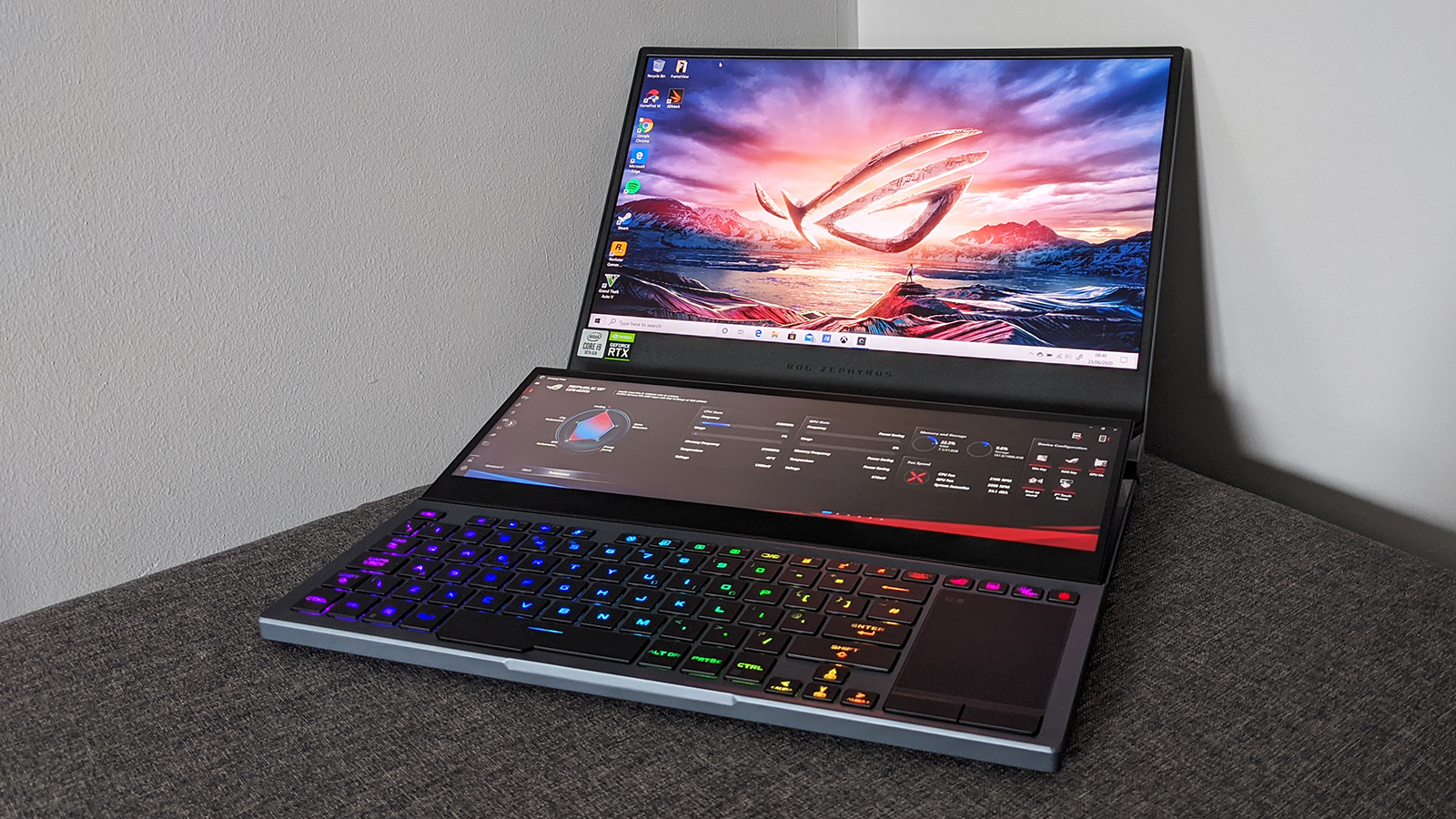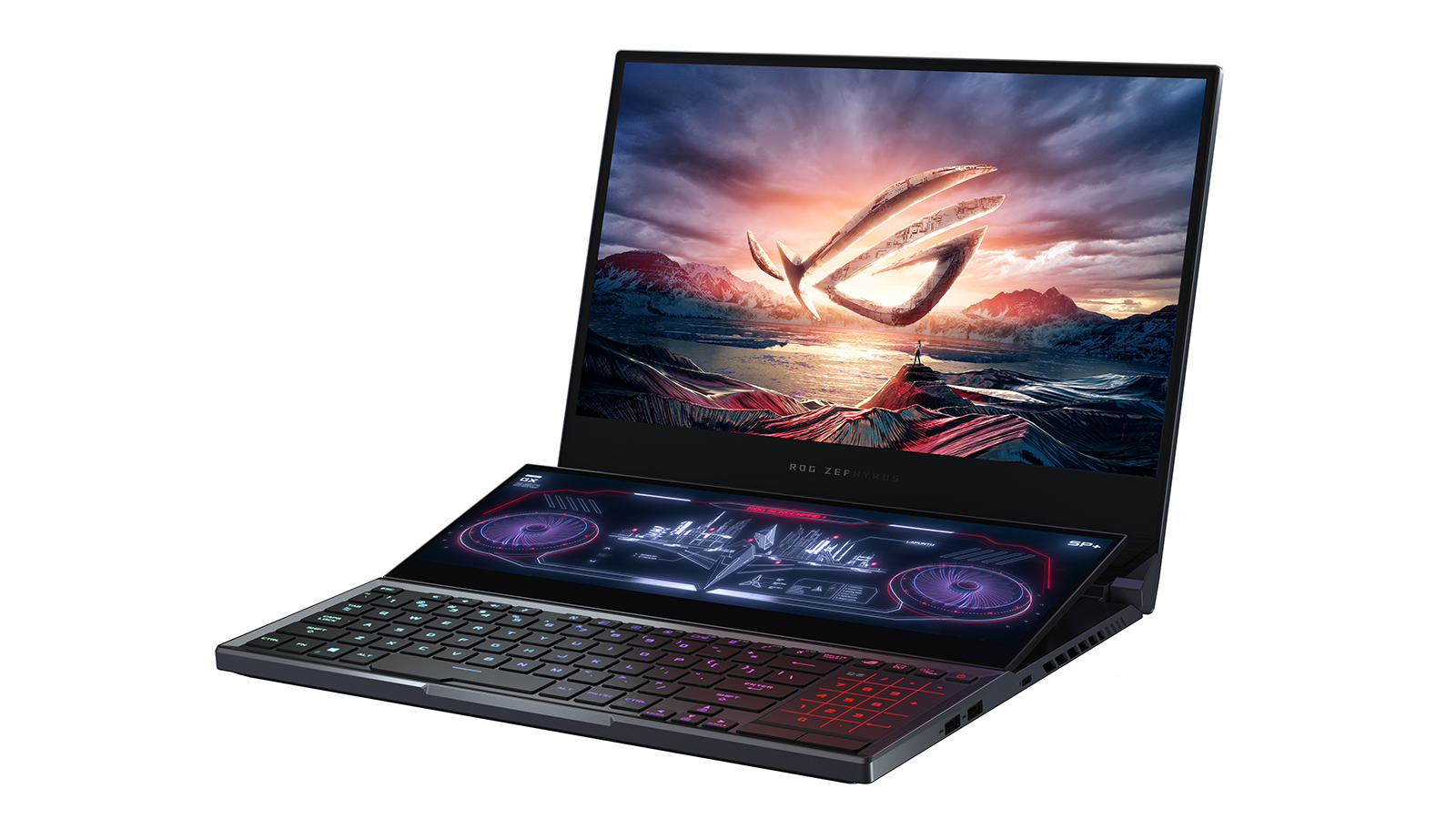Asus ROG Zephyrus Duo 15 review: an awe-inspiring dual-screen gaming laptop
The Asus ROG Zephyrus Duo 15 is a high-spec gaming laptop with a difference


The Asus ROG Zephyrus Duo 15 is an impressive but not a perfect laptop for gamers and creative professionals – it scores highly in performance, but can get hot and loud. That second screen could be the main reason why people do or don't buy this gaming laptop.
-
+
Packed with power
-
+
Innovative second screen
-
+
High-resolution 4K option
-
-
Gets loud and hot
-
-
Costs a lot
-
-
No integrated webcam
Why you can trust T3

The Asus ROG Zephyrus Duo 15 reveals its unique selling point as soon as you get it out of the box: it's got a second screen between the main display and the keyboard, available to show gaming controls, Spotify playlists, a browser window, or whatever you like really.
Besides this eye-catching hardware extra, the laptop is packed tightly with the very best components you can spend your money on, as you would expect from the Asus ROG series. We've liked a lot of these gaming laptops in the past, and this could be the best yet.
- Asus ZenBook Pro 14 review
- Need an upgrade? We've got the best gaming laptops right here
- A comprehensive list of the best 2-in-1 laptops
The usual trade-offs apply here as with most gaming laptops: this is a big, heavy, expensive bit of kit, and you shouldn't expect too much in the way of battery life. However, it should run the most demanding games you can power up on it, with some left to spare.
If you need the best possible gaming performance from a laptop, and you're prepared to pay for it, then this might be the computer for you – especially if you can work out a good use for that second screen. Read on to find out how the Zephyrus Duo 15 performs.
Asus ROG Zephyrus Duo 15 review: screen and design

The Asus ROG Zephyrus Duo 15 comes sporting a 15.6-inch, 3840 x 2160 pixel, 60Hz refresh rate, 16:9 IPS LCD display – and thanks to some thin left, top, and right bezels it really looks the part. You can opt for a 1920 x 1080 pixel, 300Hz refresh rate panel instead, if you value speed over refresh rate (which leaves you with the odd configuration of having the 14.1-inch, 3840 x 1100 pixel secondary screen running at a higher resolution than the laptop's main display).
There's no doubt that this is a gaming laptop that can turn heads, thanks to that secondary screen but also because of the understated, sleek grey casing, and those multicoloured chiclet key backlights (with a satisfying 1.4 mm travel distance). As far as connectivity goes, you've got 1 x USB-C port (supporting DisplayPort 1.4, Thunderbolt 3 and Power Delivery), 2 x USB-A ports, and 1 x HDMI port. Overall, we'd say it's a winner in the design department, as Asus ROG laptops often are.
While the looks get top marks though, we're not sure quite how practical they are. The secondary screen is a nice idea (and hides the cooling system rather well), but even in situations where it can in theory come in handy – to keep a chat window open while gaming, for example – it feels as though it would be a distraction more than anything else. In Windows, it acts just like a second monitor, so you can drag open programs down into it; but you might just be better off buying a second monitor.
Get all the latest news, reviews, deals and buying guides on gorgeous tech, home and active products from the T3 experts
The presence of the huge second screen and chassis cooling solution means the keyboard can feel rather cramped (although the keys themselves are a decent size), and the trackpad gets shifted out to the right. The trackpad is usable enough – it's actually rather good in terms of sensitivity and responsiveness – but it's small and awkwardly placed, and you're probably going to want to add a gaming mouse to the mix most of the time.
- Here are the best lightweight laptops you can buy
Asus ROG Zephyrus Duo 15 review: performance and features

Our review unit arrived with an eight-core Intel Core i9-10980HK processor plus an Nvidia RTX 2080 Super Max-Q graphics chip, both overclocked and optimised by Asus – you can buy a slightly less powerful variant as well, but this is the top of the line. Unsurprisingly, it's a brute in the performance department, handling every game we tried without a hitch – GTA V in 4K at 60 fps was managed without a single stutter that we could see.
In the 3DMark Time Spy benchmark, the Asus ROG Zephyrus Duo 15 again produced silky-smooth graphics: it hit 7,708 in the benchmark, slap bang in the middle of the average scores for "gaming laptop" (5,730) and "gaming PC" (9,216) in the 3DMark database. Under heavy load though, this laptop does run rather hot and loud – not so bad that it feels like the laptop is about to break apart, but certainly enough for you to notice it. Most of the heat flows out of the sides and underneath of the laptop with a good pair of headphones you can largely forget about it.
While some serious gamers will want more than the 60Hz refresh rate of the 4K screen, there is the alternative screen option we mentioned above if you want to ramp up the refresh rate. It's not the quietest or coolest laptop, but there's no quibbling with the quality of the components packed in here. The included Armoury Crate app, which actually uses the second screen to good effect to report system stats, showed fan speeds reaching above 4,000RPM at times.
What might also distract you from the whirring fans is the pair of downward-firing 4W speakers on either side of the laptop, which impressed us more in the audio department than we expected. As for battery life, no surprises here: a laptop this well-equipped and big isn't designed to go for hours between battery charges. In our test, an hour of video streaming knocked down the battery from a 100 percent charge to 61 percent, so you're looking at a little over two hours of light use away from a power socket.
- The complete T3 guide to the best laptops on the market
Asus ROG Zephyrus Duo 15 review: price and verdict

Get this on your shortlist if you're shopping for a gaming laptop and you have plenty of money to spend – it's absolutely packed with tech, offers high levels of performance, has impressive sound, and brings with it some eye-catching overall aesthetics as well. There's no doubt that it's one of the best gaming laptops of 2020, though that doesn't necessarily mean that it's going to be the best gaming laptop for you, of course, especially at an asking price of close to £4,000 / $4,000 for the top-end version.
Besides the high cost of the Asus ROG Zephyrus Duo 15, it's not the slimmest or lightest gaming laptop around – if you don't need to run the best games at the highest resolutions then something cheaper and lighter might suit you better. Plus, while we like the imagination of the second screen, it's not all that useful right now – it's a good idea, but it really needs more dedicated apps for it, or more support from top-tier games. The bundled Armoury Crate stats program is just about the best use of it we've found, unless you want to watch YouTube videos while you're playing.
As for the main screen, the 1920 x 1080 panel at 300Hz might be the better option to go for, especially as 4K resolutions aren't quite as noticeable on laptop screens as they are on a large PC monitor. Indeed, Asus itself is pushing the 4K model more for "pro-level content creation", and this is certainly a hugely capable machine if you're in the business of high-level video and image editing.
Even with all the top-tier components packed in here, it's perhaps the second screen that's going to convince you to either buy this or look elsewhere. If you think you can work out a good use for that tilted display, then this might just be the best gaming laptop on the market right now for those with deep pockets. If you prefer a full-sized keyboard and don't need quite so much raw power, you might find a better deal elsewhere.
Dave has over 20 years' experience in the tech journalism industry, covering hardware and software across mobile, computing, smart home, home entertainment, wearables, gaming and the web – you can find his writing online, in print, and even in the occasional scientific paper, across major tech titles like T3, TechRadar, Gizmodo and Wired. Outside of work, he enjoys long walks in the countryside, skiing down mountains, watching football matches (as long as his team is winning) and keeping up with the latest movies.
